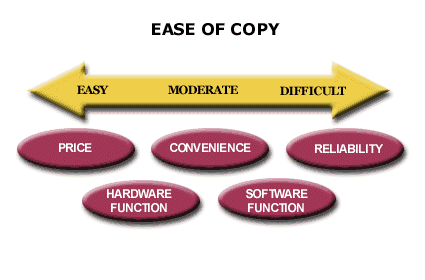Analysis 46: Ease of Copy
EXHIBITS:

HOW TO INTERPRET THE ANALYSIS: This exhibit is a conceptual diagram of the difficulty a competitor might have in copying the typical unique benefit in a Customer Buying Hierarchy category. The Ease of Copy of a benefit will vary somewhat by market, both in terms of the speed and cost of copying the unique benefit. In general, however, Price is an easy benefit to copy. Convenience is somewhat more difficult and Reliability is most difficult. A hardware Function is usually easier to copy than Convenience but less easy than Price. A software Function is easier to copy than Reliability but more difficult than Convenience.
PURPOSE: This analysis arrays the potential improvements the company can make to its product/service package, from those that are easy to copy to those that are difficult to copy. APPROACH: A product and service innovation will do the company little good unless it remains unique for a period of time, long enough to win the company new customer volume. The company should evaluate all its options to improve its product/service package to determine those that have the highest likelihood both of attracting customers and of remaining unique for some period of time. The company arrays these options across the difficulty spectrum, from those that are easiest to duplicate to those that are most difficult. The degree of difficulty is a function of the time and the cost it would take a competitor to match the level of product benefit offered by the new product and service innovation. The company would tend to choose potential innovations that are hard to copy over those that other competitors can readily match. Return to Diagnose Products and Services: History of Duplication |
|
Recommended Reading |
| For a greater overall perspective on this subject, we recommend the following related items:
Analyses: Symptoms and Implications: Symptoms developing in the market that would suggest the need for this analysis. Perspectives: Conclusions we have reached as a result of our long-term study and observations.
|
